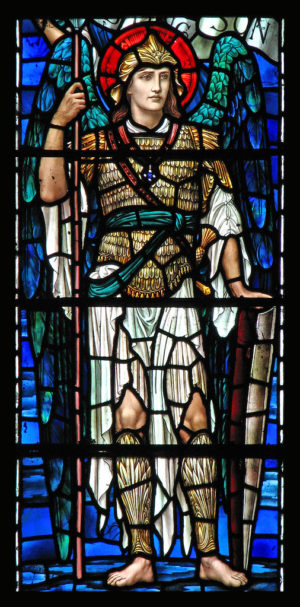SUNDAY, SEPTEMBER 29: Search for an Aster flower, make a blackberry crumble or bake a bannock today: It’s Michaelmas, the Christian feast for St. Michael the Archangel. Often depicted as a white-robed angel with his foot on a demon, St. Michael is seen as the warrior of God and, not surprisingly, has become the patron of soldiers, mariners and anyone going into battle. Autumn ushers in the darker half of the year, and by many Christians, St. Michael is prayerfully invoked for for extra protection.
WEEK-LONG GOOSE FEST: In Lewistown, Pennsylvania, today is known as Goose Day—and tourists now, ahem, flock to Lewistown for the occasion. Events are becoming so popular that many are expanding into the week preceding September 29 (read the full story in the Penn Live Patriot-News).
Beyond honoring St. Michael the Archangel, Michaelmas has taken on a seasonal association through the centuries, signaling the beginning of autumn: In the United Kingdom and Ireland, “Michaelmas” is the name of the first term of the academic year, while in Wales and England, “Michaelmas” is associated with one of four terms of the year in the courts.
ST. MICHAEL: FROM HEBREW SCRIPTURES TO THE GOLDEN LEGEND
Christianity is split on how to regard “Archangels,” but generally seven are recognized in Christian tradition—and three of them are honored liturgically. Among these, St. Michael is the seen as the greatest of all the Archangels.
Did you know? In the 5th century, a basilica near Rome was built and dedicated to St. Michael on September 30, with celebrations starting the evening before; thus, September 29 became established as the feast day for the Archangel in the Western Christian Church.
Hebrew for “Who is like God,” Michael carried the victory over Lucifer in the war of heaven. Michael appears several times in the Hebrew scriptures and generally is seen as an advocate of Israel. Michael also is honored in Islam for his role in carrying out God’s plans.
The Golden Legend describes in great detail the battles of St. Michael, but none are to be as great as his final victory over the Antichrist. According to the Golden Legend, the Archangel Michael will slay the Antichrist on the Mount of Olivet.
Note: With the exception of Serbian Orthodox Christians, most Eastern Christians do not observe Michaelmas. The Greek Orthodox Church honors Archangels on November 8.
DAISIES, APPLES AND A BLACKBERRY LEGEND
As the Aster blooms around this time each year, it has slowly gained a new name: the Michaelmas Daisy. In every color from white to pink to purple, the Michaelmas Daisy is the original flower from which lovers pick petals and alternately chant, “S/he loves me, S/he loves me not.” Gardens in England and the United Kingdom still attract throngs of visitors around Michaelmas for their glorious displays of Michaelmas daisies.
With a date near the Equinox, Michaelmas soon became associated with livestock and hiring fairs, and many events in Scotland included processions and sports. Today, Michaelmas fairs continue in some parts of England, complete with music and dancing, art and delicious fare.
Geese were once plentiful on Michaelmas—as were autumn apples—and the most popular dish of Michaelmas has always been roast goose and apples. Side dishes and desserts vary by country, with the Irish making Michaelmas Pie and Scots baking St. Michael’s Bannock, a type of scone. (Get recipes and more from Catholic Culture and FishEaters.) As folklore suggests that blackberries may not be picked after Michaelmas—because Satan fell from heaven into/onto blackberry bushes—blackberry pies and crumbles remain a popular dish for Michaelmas.
Looking for more Michaelmas goose recipes? Try Food Network and AllRecipes.



Tell Us What You Think